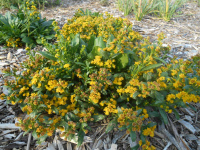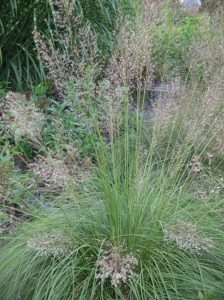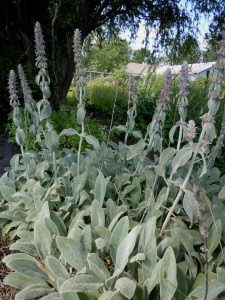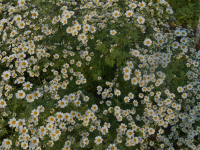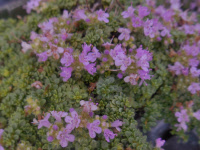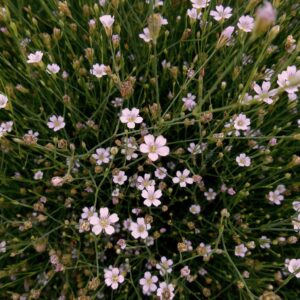Drought, Xeric & Dry Soil Plants
Showing 121–128 of 132 results
-
Solidago cutleri Cutler’s alpine goldenrod Z 3-9
Golden tufts of flowers on this mounding, compact, bone-hardy goldenrod July-September
Golden tufts of flowers on this mounding, compact, bone-hardy goldenrod July-September
Size: 6-10” x 12”
Care: sun in well-drained to moist well-drained soil
Native: Mountains of New England and NY, north through Nova Scotia
Wildlife Value: attracts butterfliesNamed for New England plant explorer Manasseh Cutler , Rhodora 10(113): 87. 1908 by M.L. Fernald
-
Sporobolus heterolepsis Prairie dropseed Zone 3 – 9
Mound of graceful thinnest of grass blades
The description in the Chiltern Seeds catalog cannot be improved: “This is the most elegant and refined of the North American prairie grasses …the finest texture composed of the thinnest of thin, thread-like, glossy green blades,.. in autumn turning deep orange before fading to a light copper for the winter. In late summer the plants bear, on very slender stalks high above the foliage, unbelievably delicate, graceful flower panicles, excellent for cutting. ”One of internationally known garden designer Piet Oudolf’s 100 “MUST HAVE” plants, Gardens Illustrated 94 (2013)
Size: 2’ x 2’
Care: Full sun in well-drained soil
Native: from Canada in the north to Texas in the south, Wisconsin native
Wildlife Value: seeds are food for birds
Awards: Missouri Botanic Garden Plant of Merit & Great Plants for Great Plains Grass of the Year.Sporobolos is Greek from sporo meaning seed and ballein meaning to cast forth because the seed readily falls from the flower (or dropseed, the common name). Ojibwa “Medicine Society” used roots to cure sores & “remove bile.”
-
Stachys byzantina Lamb’s ears, Woolly betony, Wooly woundwort Z 4-8
Pale pink-lavender flowers on silver-gray spikes in summer with foliage as soft as a lamb’s ear.
Pale pink-lavender flowers on silver-gray spikes in summer with foliage as soft as a lamb’s ear.
Size: 12 x 12 spreading
Care: Full sun in moist well-drained to well-drained soil, low fertility
Native: Iran
Wildlife Value: Drought tolerant & deer resistant.Stachys is an old greek word meaning, “spike.” Stachys was believed to cure almost everything. Italians urged people to: “sell your coat and buy betony.” The common name “woundwort” describes the leaves’ function as bandages. Cultivated by George Washington at Mount Vernon.
-
Syneilesis aconitifolia syn. Senecio aconitifolia Shredded umbrella plant; in China, tu er san Z 3-8
Grown for its excellent foliage in dry shade. I guess “Shredded umbrella” best describes this plant with thin, dissected leaves atop a leafless stem. drooping in a rounded shape, like an umbrella, but it wouldn’t shelter from rain. Pale pink to white flowers in early to mid-summer.
OUT OF STOCK
Grown for its excellent foliage in dry shade. “Shredded umbrella” best describes this plant with thin, dissected leaves atop a leafless stem. Drooping in a rounded shape, like an umbrella, but it wouldn’t shelter from rain. Pale pink to white flowers in early to mid-summer.
Size: 3’ x 2’, spreads slowly by rhizomes
Care: part to full shade in moist, well-drained to well-drained soil. Drought tolerant once established.
Native: China, Korea & Japan and eastern Russia
Wildlife Value: Attracts bees, butterflies and birds. Deer and rabbit resistant.Described in Flora of China in 1833. Chinese used the whole plant for medicine, to relax and activate the tendons, alleviate pain around the waist and legs, and to treat most any injuries.
-
Tanacetum niveum Silver tansy, Snow tansy Z 5-9
Profusion of small classic daisies May-July atop fragrant silver foliage. Cut back for rebloom. Let the seeds drop for more plants next year. If you cut them back after the 1st flowering they will rebloom for most of the summer and fall.
Profusion of small classic daisies May-July atop fragrant silver foliage. Cut back for rebloom. Let the seeds drop for more plants next year. If you cut them back after the 1st flowering they will rebloom for most of the summer and fall.
Size: 2’ x 3’
Care: sun in moist well drained soil
Native: central & southern EuropeNamed by Carl Heinrich Schultz (1805-1867)
-
Thermopsis caroliniana syn. Thermopsis villosa Carolina lupine Z 4-9
Dense spikes of buttery yellow in June, resembling Baptisia or Lupin with clover like foliage.
ARCHIVED
Note: This is a plant not currently for sale. This is an archive page preserved for informational use.
Dense spikes of buttery yellow in June, resembling Baptisia or Lupin with clover-like foliage.
Size: 4’ x 2’ spreading
Care: Sun in well-drained soil. Drought & Heat tolerant.
Native: forest openings in the Appalachians
Wildlife Value: Attracts bees & butterflies, Deer & rabbit resistant.Collected before 1843
-
Thymus serpyllum ‘Minus’ syn. T. praecox ‘Minus’ Dwarf thyme Z 4-8
Tiny-leaved, miniature thyme, lilac-colored flowers in early summer, used as a groundcover or for fairy gardens and rock gardens.
Tiny-leaved, miniature thyme, lilac-colored flowers in early summer, used as a groundcover or for fairy gardens and rock gardens.
Size: 2" x 6"
Care: sun to part shade in well-drained soil
Native: Europe
Wildlife Value: Deer resistant.
Size: Great for rock gardens, groundcover, drought tolerant.Thymus from the Greek word for “odor” due to the plant’s fragrance. Ancient Greeks made incense with thyme. ‘Minus’ described by Parkinson in 1640. He called it Thymus serphyllum vulgare minus.
-
Tunica saxifraga syn. Petrorhagia saxifraga Tunic flower Z 4-8
Free blooming pixie, palest of pink blossoms from June through October on wiry stems form a 4" tall mound.
Free blooming pixie, palest of pink blossoms from June through October on wiry stems form a 4″ tall mound.
Size: 6" x 8"
Care: Full sun in well-drained soil.
Native: Pyrenees and Alps
Wildlife Value: Drought tolerant.
Awards: Royan Horticultural Society Award of Merit.
Size: Perfect for rock gardens, front of borders or groundcover.Tunica is Latin meaning tunic or coat referring to overlapping bracts beneath the flower. Before 1753. Near the turn of the century William Robinson described the Tunic flower as having “elegant little rosy flowers … a neat plant for the rock garden and fringes of borders and thrives like a weed between the stones in a rough stone wall.” “Suggestive of a miniature gypsophila.” H.H. Thomas, 1915.

